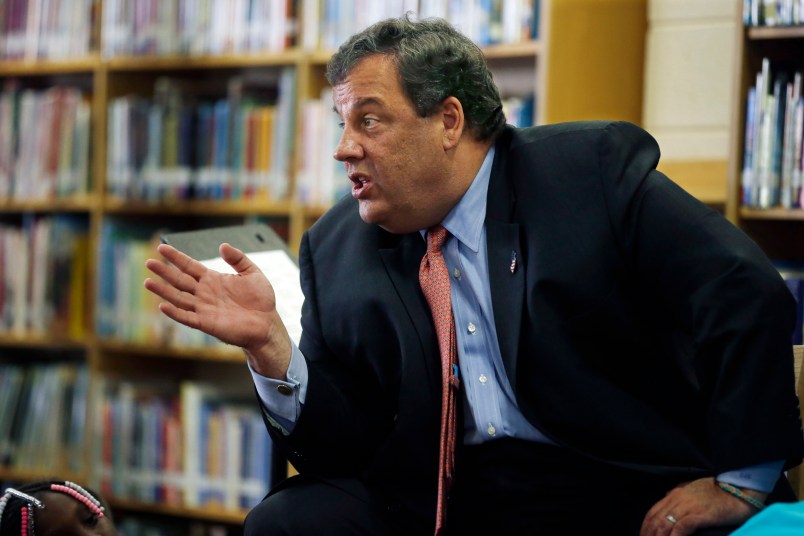The Gov. Chris Christie (R) bridge scandal metastasized on Wednesday.
Subpoenaed documents obtained by TPM and other media outlets revealed direct ties between the Christie administration and the discussion about closing lanes on the George Washington Bridge in September. The lane closures lead to a massive, multi-day traffic jam in the town of Fort Lee, N.J.
Officials with the Port Authority of New York and New Jersey, which oversees the bridge, have maintained that the lanes were closed as a result of a traffic study. But Democrats in New Jersey have dismissed that explanation. Instead, they have suggested the closures were retaliation against Fort Lee Mayor Mark Sokolich, a Democrat, who declined to endorse Christie’s re-election bid last year.
For those just tuning in, here’s a recap of some of the key dates and moments in the ongoing story.
August 13: “Time For Some Traffic Problems In Fort Lee”
According to the documents released on Wednesday, one of Christie’s closest aides was involved in a discussion about the order to close the lanes, weeks before the closure actually took place. On Aug. 13, Christie Deputy Chief of Staff for Legislative and Intergovernmental Affairs Bridget Anne Kelly sent an email to David Wildstein, a former high school classmate of Christie’s and one of the governor’s appointees to the Port Authority of New York and New Jersey.
“Time for some traffic problems in Fort Lee,” Kelly wrote.
“Got it,” Wildstein replied.
The documents released Wednesday are heavily redacted in parts, making it hard to tell if Kelly meant the traffic problems were the motivation for the closure, or whether she was anticipating the traffic as an effect of the order.
Sept. 6: The Order Comes In
Wildstein ordered the bridge’s general manager to carry out the lane closures.
Sept. 9: The Lanes Are Closed
The lane closures began. A few days later, here’s how a local news report described the results:
The Port Authority, which runs the bridge, cut the number of tollbooths from three to one on the big span and narrowed the traffic patterns on its approaches from two Fort Lee streets. Instead of three lanes, the approach from Bruce Reynolds Boulevard and Martha Washington Way funnels down to one lane that leads to a combination cash-and-E-ZPass toll booth.
Sept. 10: “Is It Wrong That I Am Smiling?”
According to the documents released Wednesday, Fort Lee Mayor Mark Sokolich texted Bill Baroni, another Christie appointee to the Port Authority of New York and New Jersey, on Sept. 10 and expressed worries about “getting kids to school.” That message appears to have been relayed to Wildstein, who replied with the following text message: “Is it wrong that I am smiling?”
Sept. 13: Fort Lee Mayor Goes Public With Suspicions
Just days after the lanes were closed, Sokolich raised the possibility that politics were involved.
“I’ve asked the Port for an explanation, but they haven’t responded,” Sokolich told a local columnist in a piece published on Sept. 13. “I thought we had a good relationship. Now I’m beginning to wonder if there’s something I did wrong. Am I being sent some sort of message?”
Nov. 25: The Grilling Begins
New Jersey legislators hold a hearing to question top Port Authority officials about the lane closures.
“You are a masterful dancer and we appreciate your dancing skills,” Assemblyman John Wisniewski told Baroni, according to WNYC.
In his testimony, Baroni told lawmakers that local mayors and transportation official were not notified about the lane closure plan due to a communication failure.
Dec. 2: Christie Speaks Out, Makes Light
Christie himself addressed the controversy for the first time. At a news conference in Trenton, N.J., Christie made light of the suggestion that he was connected to the closures.
“I worked the cones, actually,” Christie said, according to WNYC. “Unbeknownst to everybody I was actually the guy out there, in overalls and a hat.”
“You really are not serious with that question,” Christie added.
Dec. 6: First Christie Pal Resigns
Wildstein announced his decision to resign from the Port Authority of New York and New Jersey. In a letter to Baroni, Wildstein wrote that he would leave on Jan. 1 “to pursue other opportunities,” according to The Bergen Record.
Dec. 13: Second Christie Pal Resigns
Baroni followed Wildstein out the door. But unlike Wildstein, Baroni’s resignation took effect as soon as it was announced.
Christie said the resignation was “nothing that I hadn’t planned already.”
“Baroni said when he testified [during a recent hearing] that a mistake was made. They believe that the study needed to be done but they didn’t do it correctly within the protocols of the Port Authority,” Christie said. “He’s taken responsibility for that, as well he should because he’s the lead person for New Jersey at the Port.”
Dec. 18: Lawyers Get Involved
After hiring attorneys, both Wildstein and Baroni were given two more days to comply with subpoenas demanding all documents and correspondence between members of the Christie administration and Port Authority officials.
Dec. 19: Christie Calls Scandal ‘Not That Big A Deal’
At a news conference, Christie once again dismissed the scandal, and criticized reporters for focusing on it.
“I have a lot of things to do. … I know you guys are obsessed with this. I’m not, I’m really not. It’s just — it’s not that big a deal just because press runs around and writes about it both here and nationally. I know why that is and so do you,” Christie said. “Let’s not pretend that it’s because of the gravity of the issue. It’s because I am a national figure and anything like this will be written about a lot now. So, let’s not pretend.”
Jan. 8: Documents Become Public
TPM and other news outlets obtain documents that show the communications between Christie’s allies about the bridge lane closures.






